Wireless for Communities & Open Spectrum Summit
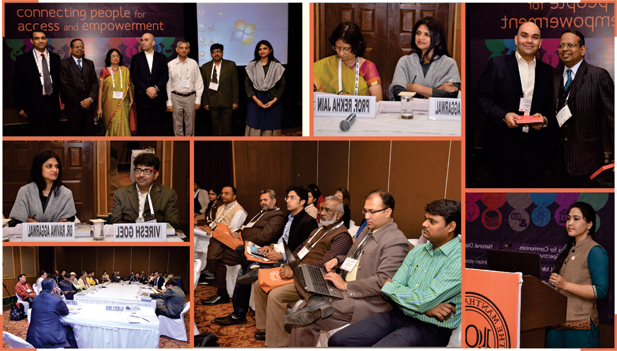
About the Summit
The national consultative summit was a first kind effort to bring all stakeholders to deliberate, discuss, share, experience and emerge with a concrete set of recommendations as how unlicensed spectrum in India can be used to serving the last mile connectivity. The summit saw stakeholders from the government departments, agencies, industry, civil society, academia, network implementers, policy advocators, wireless practitioners, and others to air views, opinions, inputs, concerns and suggestions on a wide area of topics. One unique approach was to present and share good practices and challenges in wireless network deployment and operations in India and other developing countries.
The Summit was formed in a free-flow format allowing not only experts and policy advocators to share their ideas and information but also given opportunity to each participant to share their challenges and issues. That made the session highly interactive (including the ability to converse in local languages).
Summit Objectives
Key objectives of the national summit identified were:
- Arrive at better understanding of unlicensed band, free spectrum and its importance to serve last mile connectivity
- To share good practices and challenges faced during the wireless network deployment and operations in India and other developing countries
- Deliberate on the need availability & challenges of appropriate wireless technologies to bridge access and connectivity divides
- To bring implications related to wireless, mobile & broadband technologies which help transcend traditional infrastructural bottlenecks in rural areas of India
- To emerge with working framework with necessary inputs, suggestions, comments, recommendations on ways to connect the government and business services that can reach the masses through the wireless and mobile networks in local languages and in oral medium
Summit Broad Areas
In light of the above, the summit discussed the following broad areas:
- 1.Discuss the importance of free spectrum for public good and advocacy towards utilizing it for social development
- 2. To understand the scope and opportunities of unlicensed spectrum in India and other developing countries
- 3. The magnitude and extent of unlicensed wireless band/free spectrum can be used to connect isolated areas and communities of the country.
- 4. Explore and understand the rights and ethics challenges and issues around unlicensed spectrum
Summit Themes
The consultative summit deliberated on the following themes:
- 1. Access, rights & ethics for providing uniform wireless
- 2. Economic and social advancement of using wireless network
- 3. Developing uniform policy framework for unlicensed spectrum
Summit Outcome
The national summit looked at the following key outcomes
- 1. Consolidate factors and inputs to uniform policy framework for unlicensed wireless spectrum;
- 2. Consolidate solutions towards issues related to media, access and rights, ownership of unlicensed spectrum, ownership of accessibility and exploring opportunities in terms of accessibility;
- 3. Building a roadmap towards a working framework on adopting cost-effective technologies to propagate the wireless network networks far and wide across the country for ensuring equality of access, digital equity and media access.
- 4. Consolidating scope of policy areas and suggest workable action steps;
Summit Proceedings
The summit was formed in a discussion-oriented format sharing the case studies around wireless network deployment and operations in India. The focus of the summit is to empower rural communities via providing them affordable internet connectivity. The summit also focused on understanding the importance of unlicensed band and how wire and wireless network can be used together to provide uniform internet access across the country. The Summit was chaired by Mr. N. Ravi Shankar, MD, BBNL & Administrator of USOF, DoT, MoCIT and moderated by Mr. Rajneesh Singh, Regional Bureau Director for Asia, ISOC.
Chairperson & Keynote Address: N. Ravi Shankar, MD, BBNL & Administrator, USOF, DoT, MoCIT
Moderator
- Rajnesh Singh, Regional Bureau Director for Asia, ISOC
Panelists - Deepak Maheshwari, Public Policy Professional
- Dr. Ravina Aggarwal, Program Officer for Media Rights and Access, Ford Foundation
- Prof Rekha Jain, Executive Chair, IIMA-IDEA Telecom Centre of Excellence & Professor, Computers and Information Systems Group, IIM –Ahmadabad
- Vibhas Sharma, Founding Director and CEO, Aura Ventures Pvt. Ltd.
- Viresh Goel, Deputy Wireless Adviser (T), WPC Wing
- Shahid Ahmad, Project Director, DEF
The Proceedings
Moderator, Mr. Rajneesh, initiated the summit by the introduction of panelists and participants. Further, he raised the question with N. Ravi Shanker to share his opinion and feedback on fibre optic network and what is the mission of government in terms of connecting the country.
Mr. N. Ravi Shanker initiated the discussion sharing mission of Telecom Ministry, Govt. of India – ‘Internet of people to Internet to things’ is theme of the National Telecom Congress which is inaugurated on 5 December 2013. He further mentioned there is a need that all kind of technologies should reach rural parts of the country. For example voice communication is still missing in several parts of the country. About 90% of the country has luxury to have towers and this is endeavor of the Telecom Ministry. The government is trying to bring each and every kind of technologies such as 2G, 3G, 4G and community wireless network, community radio, etc. He further explained there is a need to understand how technology permits to the rural area and how technology has been acting as a democratizing element. Mr. Ravi Shanker welcomed all panelists and participants and requested them to share their feedback and add valuable experiences in the summit.
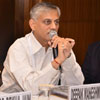
Deepak Maheshwari, Public Policy Professional
To take the discussion forward – moderator, Mr. Singh introduced Deepak Maheshwari, who is Public Policy Professional and worked with various organisations, and asked to share his experiences on how rural wireless is fitting into wholesome picture of wireless network specifically from the policy framework angle.
Deepak initiated the discussion giving three basic facts regarding the spectrum. Firstly the spectrum is one resource that is common in each country. Secondly in comparison to urban regions, spectrum is largely available in rural areas because number of users in metro/cities is larger than the rural areas. Thus overall usage in rural areas is less than urban.
Talking about earlier days of spectrum, he mentioned that 11 years back, using wireless technology was illegal. In 2003, the Wireless Planning & Coordination (WPC) wing of the Department of Telecommunications delicensed 2.4 GHz and 5.8 GHz frequency that can be used as unlicensed spectrum. In the last decade, unlicensed spectrum has come into its existence and it can be used by community members.
Describing about delicensed spectrum, he mentioned that delicensed spectrum is like pedestrian path which means that anybody can use this spectrum. Non-exclusive, non-interfering, and non-
protection are three features of unlicensed spectrum. Non-exclusive means unlicensed spectrum cab be used by anybody and everybody. Non-interfering means spectrum usage should not disturb others. Non-protecting means that usually ISP providers use antenna gain to receive better signal.
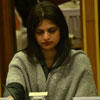
Ravina Aggarwal, Program Officer for Media Rights and Access, Ford Foundation
In order to understand ethics of unlicensed, Ravina Aggarwal, Program Officer for Media Rights and Access, Ford Foundation initiated the discussion with Ford Foundation’s principle of providing universal access in rural regions of the country. Describing about Ford’s objectives, Ms. Aggarwal mentioned that we are addressing the issue of access. Through several ground projects, Ford Foundation is trying to understand how internet as a resource can be implemented uniformly and right to education, right to information, right to freedom of expression can be exercised through this medium.
She further explained that there is no use of such policy planning until and unless it cannot be used at ground level. Thus in order to bring strengthen ground practices, Ford Foundation is working with DEF and AirJaldi and promoting them to small and rural enterprises. In addition, she further explained if infrastructure and low-cost technologies are available then it is also important to have rural and small enterprises and to have bottom-up approach for wireless planning. Moreover, internet is different type of technology that can be devised differently and its infrastructure can be used differently.
In terms of telecom policy, Ms. Aggarwal emphasized on making policies for rural-level entrepreneurs/players who want to serve rural parts of the country and they should be allowed to be partnered with large level players. Thus, the infrastructure can be used for various purposes – telemedicine, education, providing e-governance services.
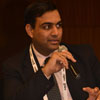
Major Vibhas, Founding Director and CEO, Aura Ventures Pvt. Ltd
To understand the aspects of wireless networks from the perspective of private stakeholder, moderator, Mr. Rajneesh raised a question from Vibhas Sharma who is Founding Director and CEO, Aura Ventures Pvt. Ltd. what are the challenges of private stakeholders in terms of providing wireless connectivity.
Giving the perspective of private stakeholders, Vibhas shared that Aura Ventures has been initiated a year ago with a mission to increase broadband penetration through the village level entrepreneurs. This could only be possible if village-level entrepreneurs can be trained on skill development in a cost-effective manner.
Therefore, Aura started evaluating the reach of broadband in semi-urban and rural parts of the country. To find out aspiration at village level, considering the fact that language is barrier, Aura started giving training and capacity building using YouTube as a medium. At initial stage, Aura
started providing 2MBPs connection which was affordable and able to provide the last mile connectivity.
Talking about the cost of internet in today’s situation, Vibhas mentioned that the cost of internet is still Rs. 3000 (~50 USD) using either TP link, microtek radio. This could be taken under through USOF (Universal Service Obligation Fund of India) as it provides fund for establishing infrastructure. While evaluating broadband reach in project area Wajirabad (nearby Gurgaon), Aura Ventures identified that cable TV operators were keen to explore other opportunities as they were stuck on CAS (Conditional Access System) or digitization process. Because of this process they were earning just INR 250 (~5 USD). Thus, Aura has created village level entrepreneurs through Cable TV operators as cable TV is going in every house. Presently, Aura has signed a master distributer with RailTel Corporation of India.
Thus, Aura envisioned that reliable bandwidth is available at every railway station across every district of the country. This bandwidth is easily available to access. Therefore, if fibre optic can be used as backhaul network and cable TV networks on fibre that can be used for providing internet. Moreover, within 2KMs of that region, network can be created that can be used by communities. This kind of network will cost approx. Rs. 1800 per customer (~36 USD) or Rs. 1800(~36 USD) per household which is equal to the cost of dongle. Thus, YouTube can be used for distributing content and making rural villagers to understand the importance of internet.
In congruence with Mr. Sharma, MD of BBNL & Administrator of USOF, Mr. N. Ravi Shanker stated that government is aiming to provide fibre optic at gram panchayat (village council) level and other alternative technologies such as wireless network, cable TV operators can be used to telecast the information. Thus, cable TV wires can be used for telecasting the information but also broadcasting the information and to take act as two-way information system. Thus, education, governance, health services can be revolutionized using these kinds of technologies. Additionally due to the cable TV Operator being a Village Level Entrepreneur, the Service Levels can be maintained satisfactorily to create a sustainable broadband model.
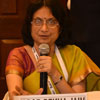
Rekha Jain, Executive Chair, IIMA-IDEA Telecom Centre of Excellence & Professor, Computers and Information Systems Group, IIM –Ahmadabad
Ms. Rekha Jain initiated the discussion with the recommendation point of having village-level wireless operators and these operators should be managed by communities over there. Though government is providing hardware which is just basic infrastructure at panchayat (village council) however, there is need of Softer(ware) – content at panchayat level need to provided, which can be easily accessible and affordable. Talking about organizational structure of BBNL (Bharat Broadband Network Limited), she emphasized that there is also need of involvement from civil society, academia, private, individual entrepreneurs in BBNL. This of multi-stakeholder ecosystem will not only strengthen BBNL policy system but also resolve operational issues. Web hosting is another issue in the country as website development is an easy task; however, hosting them is an issue.
At last, she recommended to developing a mechanism for content that could be easily affordable. This content needs to be managed and developed by communities. For example, Ministry of Human Resource Development (MHRD) who has already digitized books and courses can make them easily available. Similarly, other government departments, agencies can also take part in developing and providing community-based content as per the need of communities.

Viresh Goel, Deputy Wireless Adviser (T), WPC Wing
Describing about the mission of WPC wing, Mr. Viresh Goel, Deputy Wireless Advisor of WPC Wing mentioned that it is true that spectrum is more available in rural parts of the country rather than urban cities. Delicensed of spectrum has taken all over the world through which unlimited information can be provided to the world.

Shahid Ahmad, Project Director, DEF
To understand challenges of being rural ISP, Mr. Singh asked Mr. Shahid Ahmad, Programme Manager at DEF to share his experiences of implementing wireless networks in rural regions of the country. Mr. Shahid initiated the discussion that presently DEF has implemented 7-8 wireless networks. Understanding the theoretical aspects of technology is entirely different from implementing it in practical situation. Moreover, being a technical person, instead of reading technical aspects of the networks, these days technologist needs to read a lot of government rules and regulations which is tough to understand.
Counting his challenges at ground at Sankalp Foudation’s Bhawargarh centre, he mentioned that laying out 32 meter was not that tough instead of making it legal because according to government the height of tower should not be more than 5 metre in any government approved building. Thus, SACFA clearance was must for which we have applied three months ago, but there is no response. Secondly equipment’s are available in the country as per government norms and bandwidth is available for personal usage, however, distribution is not allowed as if we distribute the bandwidth, if any problem arises then distributer will be trouble.
This is where – we want to make a strong recommendation for the need of rural Internet service providers (R-ISPs). For example, in Guna district, majorly populated by Sahariya and Bheel tribe, most of
ISPs do not have the feasibility to provide seamless connectivity in a cost-effective manner in remote areas of the district.
Talking about kind of ISPs in India, he mentioned that there are three levels of ISPs who are providing their services at national, state and districts in terms of license, fees and jurisdiction. Ironically, on an average, there are 11.7 operators per circle who are paying minimum licensing fee of Rs. 0.25 million for the district level (Category C). Most of these ISPs are biased towards economic sustainability instead of connecting community-based approach. And even if one has a capacity to provide broadband internet in rural areas, at the backend, one has to be dependent on state-owned firm, Bharat Sanchar Nigam Ltd. (BSNL). So, the question arises – do we have sufficient number of internet providers to connect entire India?
Recommendations
1. One of the major recommendation came out is to understand how technology permits to the rural area and how technology has been acting as a democratizing element;
2. Harmonised regulatory approval processes and finite approval timelines, appropriate licensing mechanism is very much required for the last mile connectivity or at community level (using a rural ISP type model or perhaps the highly successful cable TV retailer model in India), deployment and access costs that are affordable to the target community, business and sustainability models and the importance of knowledge sharing between communities and practitioners.
3. One of the strong recommendations that has been emerged that DOT (Department of Telecom), TRAI (Telecom Regulatory Authority of India) should look at policy aspect of unlicensed spectrum and make other spectrums to be delicensed not only villagers but internet proliferation in general;
4. Regulations like using premium bandwidths on shared basis for both paid as well as non-paid spectrum can be initiated in India to solve the issues related to substandard quality of ISP service. Though there are issues like security, interference and even non-working of the business model, however, there is need to rework on sharing model of spectrum;
5. Another major recommendation is to develop sustainable social enterprises and to generate strong demand at the lowest price that could work for the poor. There is also need to understand the price-factor which has to be reduces before it reaches at grassroots level;
6. It must be mandatory to understand whether rural communities are able to harness the benefits of the existing bandwidth;
7. In terms of new policies, policy makers and government needs to come forward and provide any kind of subsidy to internet users rather than internet service provider.
8. Assessing the potential of open spectrum or rural broadband networks, first steps of bringing out sustainable models in semi-urban cities and towns, so that rural communities can also get inspired and look upon these models. In result, it will create an ecosystem and help rural regions to be connected with the mainstream.
9. Instead of always talking about bureaucratic hurdles, there is a need of bringing all kind of technology in rural areas right now, not after the 5 years as these technologies can drastically change the lives of villagers.
10. Being most of rural broadband is state controlled mostly (through BSNL) and this needs to change by opening up infrastructure for shared usage and subsidy depending on location of installation. On understanding the requirements of rural broadband networks, there is need to analyze ways and models which can fill in gap with provision some level of subsidy or tax exemption for ISPs.
11. There is a need to explore alternative solutions such as fibre optic as backhaul option and other solutions such as cable network, wireless networks to provide the last mile connectivity.
12. There is a need to explore opportunities of 5Cs approach – content; connectivity; cost of devices, competitive tariff, and computer literacy and to implement the concept of wholesaler, retailer and distributer to provide internet connectivity at rural parts of the country;
13. There is a need to emphasize on making policies for rural-level entrepreneurs/players who want to serve rural parts of the country and they should be allowed to be partnered with large level players. Thus, the infrastructure can be used for various purposes – telemedicine, education, providing e-governance services.
